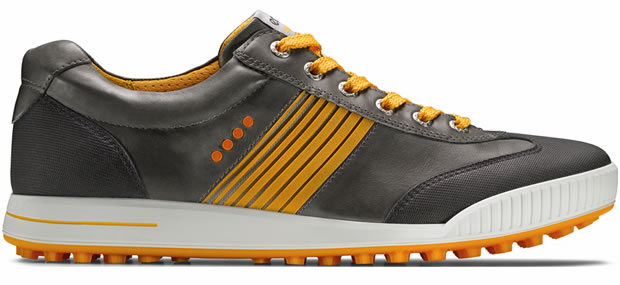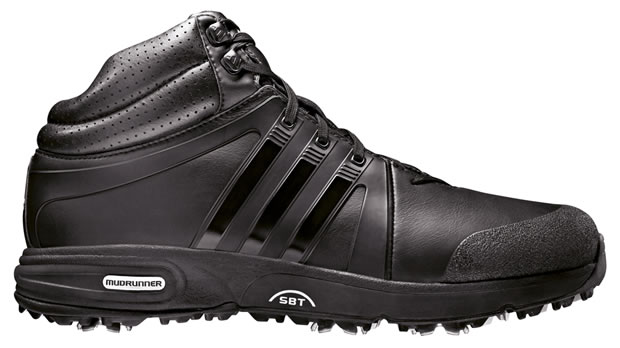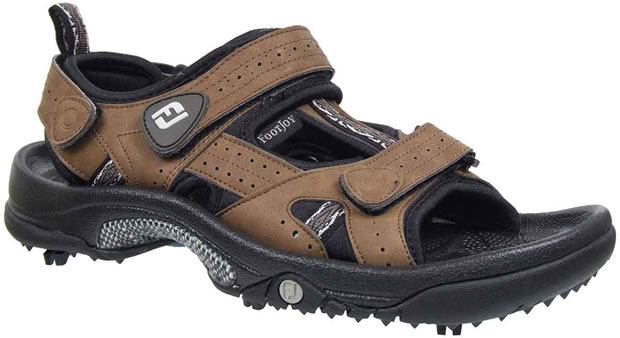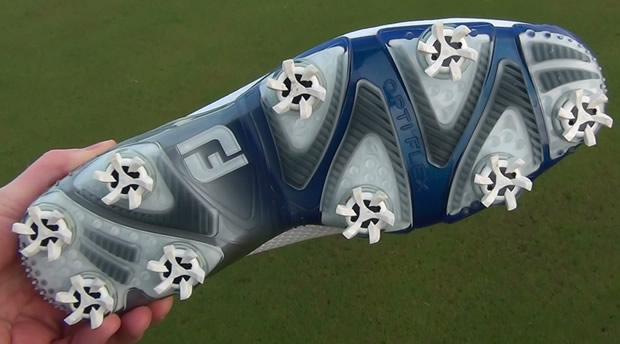A good pair of golf shoes is essential to allow you to enjoy your time on the course.
The majority of golfers still walk around the golf course and golf shoe manufacturers have poured significant resources into research and development to ensure you can do that in comfort whilst also assisting you to play better golf.
Pushing the limits of sole, upper, spike and water-resistant technology, today’s shoes are a key weapon in your armoury and deserve to be labelled as ‘game-improvement’ tools.
The following information will help you understand what golf shoes can offer you and assist you in finding the pair for you:
Types Of Golf Shoe
Spiked or Cleated Golf Shoes

The classic spiked golf shoe offers comfort, breathability, water resistance, style and traction. Finding the right pair for you is based on personal taste and what you want the shoe to deliver.
You need to decide what it is you want from your golf shoe; a waterproof shoe? A shoe to wear in all conditions? A lightweight shoe? Colour? Soft or Metal Spikes? Whatever you need in your shoe, you will find in today’s market.
A key advantage of spiked golf shoes is the stability that it can bring to your swing through better grip and because the upper of the shoe is likely to be more stable.
Modern technology has allowed traditional shoes to develop that are both lightweight and offer the stability demanded by serious players, however there can be a trade off so bear this in mind when you buy.
Spikeless Golf Shoes

The most recent development in shoes has been the introduction and success of the Spikeless or Street Shoe.
Essentially designed for comfort and style, these low-profile shoes tend to be lightweight and flat soled. Most use rubber studs or dimpled soles in place of standard golf spikes, giving the advantage of being perfect for the 19th hole and firm surfaces like the driving range.
Many professionals now wear street-style shoes, either for the look or the comfort that can aid back and foot pain, so they are not just for the casual golfer.
The trade-off of a street shoe will be less stability, grip and waterproofing. The moulded soles will offer less grip in longer and wet grass and typically they are not designed to provide waterproofing.
Initial concerns re the durability of the spikeless soles and the inability to replace worn spikes have been eased by development of new rubber technologies that manufacturers claim will outlast the natural lifetime of these types of shoe.
Golf Boot

A rare version of golf shoe, the golf boot is golf's defence to mother nature. Designed to look very similar to a hiking boot or wellington boot, the golf boot is a very waterproof alternative to a shoe. Whilst they may be heavier and not allow as much freedom around the ankles during the swing, they offer great traction and warmth for those winter months of golfing. Some models also offer gaitors for increased water protection. They can be a little expensive due to the thick waterproof material used over the entire boot, but they will keep all manner of water and mud out.
Golf Sandal

Golfers in hot climates inspired this type of golf shoe onto the market and so shoe manufacturers came up with this sandal version of a golf shoe. The open, toeless design means that are very breathable for summer wear. Great for buggy golf, they can prove uncomfortable for long walks with the straps causing a risk of a blister or two. Cheaper than most golf shoes, they offer a somewhat limited resistance to wet weather and less lateral support than a normal golf shoe, but at least your feet will be cool.
Golf Shoe Materials
Golf shoe materials have developed enormously over the past few years with a number of man-made products now utilised in both the upper and outsole to provide a combination of comfort, stability and waterproofing.
Leather
Leather is by far the most popular choice for golf shoes across the market and rightfully so. The leather is processed and then added to the exterior of the shoe creating a stretch-free, tight-fitting waterproof shoe. Usually it comes in a saddle for design to stabilize the surface of the shoe and is a good option for summer golf, as it is more breathable than other materials. Top manufacturers may offer a one or two year waterproof guarantee, but the price of the leather and the manufacturing is reflected in the price, so be prepared to pay for quality.
Waterproof Linings
The top material when it comes to a waterproof shoe is Goretex, but other manufacturers have their own versions. Extremely thick and very water resistant it is a popular choice for winter play. The material is breathable and fully waterpoof and will feel considerably warmer than leather, which means it may not be the right shoe for hot summer golf or golf abroad.
Synthetic
The cheaper alternative to leather uses a man-made upper rather than a material to cover the shoe. It is nonporous polyester that is spread over the shoe that protects the outer shell of the shoe. This type of lining is lighter and thinner than leather, meaning the price of the shoe is less but may not be as breathable. These shoes are by far less common as manufacturers are able to produce cheaper shoes with alternative man-made materials that offer more comfort and breathability.
Golf Spikes
Good traction is essential for the golf swing so how your shoe is anchored to the ground is a key consideration.
Soft or Plastic
Plastic Spikes are by far the most popular type of golf spike today on club golfer’s shoes. They are more lightweight and are far less likely to tear up a green than metal spikes as the wider size of the spike spreads the weight of the player across a wider area.
Ideal for hard summer conditions, the technology of plastic spike design is advancing so that soft spikes offer the same or greater amounts of traction as more traditional metal spikes. They are also more comfortable as the legs or the spike will flex as you wlak on them. Easily changed, the plastic spike will be found on almost all new golf shoes on the market today and is a safe choice.

Metal
Becoming less and less common, the metal spike is a still used by many tour pros. Metal spikes have longer sharper spikes that give more traction on the course than plastic. However, metal spikes are infamous for tearing up greens and fairways worse than plastic. Under the rules of golf, players cannot repair spike marks on greens, so plastic spikes have become the common choice for club players in today's game. Metal spikes may also prove uncomfortable on hard ground and cause some discomfort.
Many golf courses ban the use of metal spikes on their greens, so it may be worth checking ahead if you are going to play another course or abroad to see whether or not a switch to plastic spikes may be a good idea.
Fitting New Spikes
Not all golf shoes have the same type of fastening system so when you are swapping spikes, make sure you have the right type of replacement spikes. Most brands have wear indicators like a tyre to show when they should be replaced and it can often make an old pair of shoe feel like new when the grip is improved.
Lacing Systems
Traditional shoe laces are still by far the most common form of doing up your golf shoe however you should be aware of other alternatives.
As street and spikeless shoes have become increasingly popular some models have incorporated a more casual fastening approach, such as Velcro, to aid the ease of securing and removal of the shoe.
Some manufacturers have introduced proprietary lacing systems in some of their models that secure the shoe in the same way that ski-boots operate. These are mechanical lacing systems that aim to provide consistent stability by preventing the loosening throughout a round. These options are typically more expensive than the same model of shoe with traditional laces.
